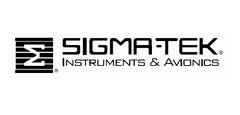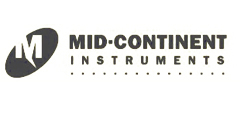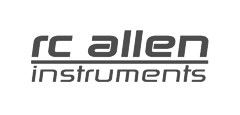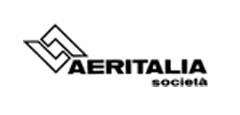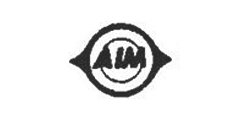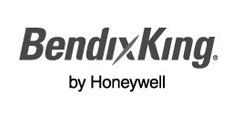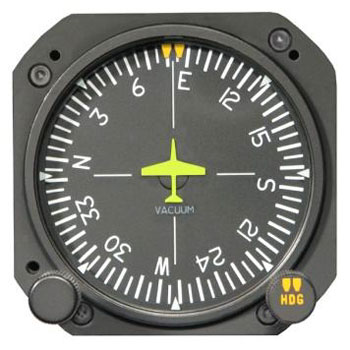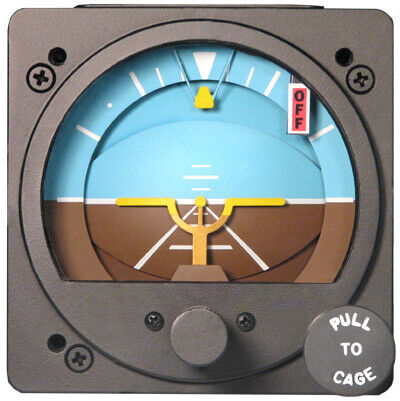Need A Packing Slip?
Be sure to send your contact info with your instrument.
CLICK HERE
For a Packing Slip
Shipping Information
All instruments (cores, repair units, and warranty units) should be shipped directly to:
Nu-Tek Aircraft Instruments, Inc.
7169 SW Santa Fe Lake Road
Augusta, KS 67010
Please cap all holes in pneumatic instruments. Insert work order instructions and reason of failure. Preferred shipping is Air Freight. Feel free to use one of our Packing Slips which will help you provide the necessary information need in order to get your instrument returned to you as soon as possible.
Packing Slip Tips
Payment Options
Credit Card - We'll contact you once the work is complete to get your Credit Card information from you then
C. O. D. - Take payment abound delivery
Prepay - Please contact us before shipping your instrument for actual cost.
Account - If you would like setup an account please contact Kathy in order to fill out the necessary information
Coupon Code/Where'd you hear about us
We run several Discount Ads appreciate knowing where you found them and where you heard about us.
Everything else should be pretty straight forward but if have any questions about shipping please contact us.
Attitude Gyro
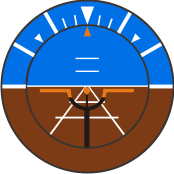 An attitude indicator (AI), also known as gyro horizon or artificial horizon or attitude director indicator (ADI, when part of an Electronic flight instrument system), is an instrument used in an aircraft to inform the pilot of the orientation of the aircraft relative to Earth's horizon. It indicates pitch (fore and aft tilt) and bank (side to side tilt) and is a primary instrument for flight in instrument meteorological conditions.
An attitude indicator (AI), also known as gyro horizon or artificial horizon or attitude director indicator (ADI, when part of an Electronic flight instrument system), is an instrument used in an aircraft to inform the pilot of the orientation of the aircraft relative to Earth's horizon. It indicates pitch (fore and aft tilt) and bank (side to side tilt) and is a primary instrument for flight in instrument meteorological conditions.
Attitude indicators are also used on manned spacecraft, where they indicate the craft's yaw angle (nose left or right) as well as pitch and roll, relative to a fixed-space inertial reference frame.
The essential components of the indicator are:
"miniature airplane", horizontal lines with a dot between them representing the actual wings and nose of the aircraft.
the center horizon bar separating the two halves of the display, with the top half usually blue in color to represent sky and the bottom half usually dark to represent earth.
degree indices marking the bank angle. They run along the edge of the dial. On a typical indicator, there is a zero angle of bank index, there may be 10 and 20 degree indices, with additional indices at 30, 60 and 90 degrees.
If the symbolic aircraft dot is above the horizon line (blue background) the aircraft is nose up. If the symbolic aircraft dot is below the horizon line (brown background) the aircraft is nose down. The fact that the horizon moves up and down and turns, while the symbolic aircraft is fixed relative to the rest of the instrument panel, tends to induce confusion in trainees learning to use the instrument; a standard mental corrective provided by flight instructors is "Fly the little airplane, not the horizon."
A 45 degree bank turn is made by placing the indicator equidistant between the 30 and 60 degree marks. A 45 degree bank turn is usually referred to as a steep turn.
The pitch angle is relative to the horizon. During instrument flight, the pilot must infer the total performance by using other instruments such as the airspeed indicator, altimeter, vertical speed indicator, directional gyro, turn rate indicator, and power instruments, e.g. an engine tachometer. "Performance = Attitude + Power".
Directional Gyro
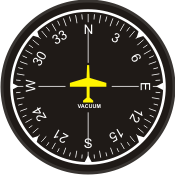 The heading indicator is a flight instrument used in an aircraft to inform the pilot of the aircraft's heading. It is sometimes referred to by its older names, the directional gyro or DG, and also direction indicator or DI.
The heading indicator is a flight instrument used in an aircraft to inform the pilot of the aircraft's heading. It is sometimes referred to by its older names, the directional gyro or DG, and also direction indicator or DI.
The primary means of establishing the heading in most small aircraft is the magnetic compass, which, however, suffers from several types of errors, including that created by the "dip" or downward slope of the Earth's magnetic field. Dip error causes the magnetic compass to read incorrectly whenever the aircraft is in a bank, or during acceleration, making it difficult to use in any flight condition other than perfectly straight and level. To remedy this, the pilot will typically maneuver the airplane with reference to the heading indicator, as the gyroscopic heading indicator is unaffected by dip and acceleration errors. The pilot will periodically reset the heading indicator to the heading shown on the magnetic compass.
The heading indicator works using a gyroscope, tied by an erection mechanism to the aircraft horizontal, i. e. the plane defined by the longitudinal and the lateral axis of the aircraft. As such, any configuration of the aircraft horizontal that does not match the local Earth horizontal results in a gimbal error, essentially leading to a variation in the predictable "apparent" wander, known in this instance as drift. The heading indicator is arranged so that only the horizontal axis is used to drive the display, which consists of a circular compass card calibrated in degrees. The gyroscope is spun either electrically, or using filtered air from a vacuum pump (sometimes a pressure pump in high altitude aircraft) driven from the aircraft's engine. Because the Earth rotates (ω, 15° per hour), and because of small accumulated errors caused by friction and imperfect balancing of the gyro, the heading indicator will drift over time, and must be reset from the compass periodically.The apparent drift is predicted by ω sin Latitude and will thus be greatest over the poles. Another sort of apparent drift exist in the form of transport wander, where aircraft movement will essentially add or subtract to the effect of the Earth's rotation upon a gyroscope. To counter for the effect of Earth rate drift a latitude nut can be set (on the ground only) which induces a (hopefully equal and opposite) real wander in the gyroscope. Normal procedure is to realign the direction indicator once each ten to fifteen minutes during routine in-flight checks. Failure to do this is a common source of navigation errors among new pilots.
Turn and bank
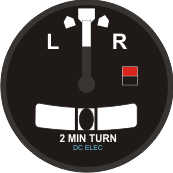 The turn indicator, Turn and bank, or turn and slip are a gyroscopic instrument that works on the principle of precession. The gyro is mounted in a gimbal. The gyro's rotational axis is in-line with the lateral (pitch) axis of the aircraft, while the gimbal has limited freedom around the longitudinal (roll) axis of the aircraft.
The turn indicator, Turn and bank, or turn and slip are a gyroscopic instrument that works on the principle of precession. The gyro is mounted in a gimbal. The gyro's rotational axis is in-line with the lateral (pitch) axis of the aircraft, while the gimbal has limited freedom around the longitudinal (roll) axis of the aircraft.
As the aircraft yaws, a torque force is applied to the gyro around the vertical axis, due to aircraft yaw, which causes gyro precession around the roll axis. The gyro spins on an axis that is 90 degrees relative to the direction of the applied yaw torque force. The gyro and gimbal rotate (around the roll axis) with limited freedom against a calibrated spring. The torque force against the spring reaches an equilibrium and the angle that the gimbal and gyro become positioned is directly connected to the display needle, thereby indicating the rate of turn.[3] In the turn coordinator, the gyro is canted 30 degrees from the horizontal so it's responsive to roll as well as yaw.
The display contains hash marks for the pilot's reference during a turn. When the needle is lined up with a hash mark, the aircraft is performing a "standard rate turn" which is defined as three degrees per second, known in some countries as "rate one." This translates to two minutes per 360 degrees of turn (a complete circle). Indicators are marked as to their sensitivity,[4] with "2 min turn" for those whose hash marks correspond to a standard rate or two minute turn, and "4 min turn" for those, used in faster aircraft, that show a half standard rate or four minute turn. The supersonic Concorde jet aircraft and many military jets are examples of aircraft that use 4 min. turn indicators. The hash marks are sometimes called "dog houses," because of their distinct shape on various makes of turn indicators. Under instrument flight rules, using these figures allows a pilot to perform timed turns in order to conform with the required air traffic patterns. For a change of heading of 90 degrees, a turn lasting 30 seconds would be required to perform a standard rate or "rate one" turn.
Coupons
ONLY ONE COUPON per order. All coupons are NOT valid on exchanges or outright purchases either new or used.
Coupon 1
Recieve 10% Off Overhaul or Repair Services
Coupon 2
Recieve 2 Day Air Service for the price on Ground (Continental USA only)
Print one of these coupons or mention one of the coupon codes on your Packing Slip and send it in with your instrument to receive the discount. If you’re exchanging your instrument please mention one of these codes in your email, fax or phone call to receive the discoun
Turn Coordinator
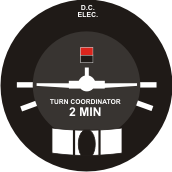 The turn coordinator (TC) is a further development of the turn and slip indicator with the major difference being the display and the axis upon which the gimbal is mounted. The display is that of a miniature airplane as seen from behind. This looks similar to that of an attitude indicator. "NO PITCH INFORMATION" is usually written on the instrument to avoid confusion regarding the aircraft's pitch, which can be obtained from the artificial horizon instrument.
The turn coordinator (TC) is a further development of the turn and slip indicator with the major difference being the display and the axis upon which the gimbal is mounted. The display is that of a miniature airplane as seen from behind. This looks similar to that of an attitude indicator. "NO PITCH INFORMATION" is usually written on the instrument to avoid confusion regarding the aircraft's pitch, which can be obtained from the artificial horizon instrument.
In contrast to the T/S, the TC's gimbal is pitched up 30 degrees from the lateral axis. This causes the instrument to respond to roll as well as yaw. This allows the instrument to display a change more quickly as it will react to the change in roll before the aircraft has even begun to yaw. Although this instrument reacts to changes in the aircraft's roll, it does not display the roll attitude.
The turn coordinator may be used as a performance instrument when the attitude indicator has failed. This is called "partial panel" operations. It can be unnecessarily difficult or even impossible if the pilot does not understand that the instrument is showing roll rates as well as turn rates. The usefulness is also impaired if the internal dashpot is worn out. In the latter case, the instrument is underdamped and in turbulence will indicate large full-scale deflections to the left and right, all of which are actually roll rate responses. In this condition it may not be possible for the pilot to maintain control of the aircraft in partial-panel operations in instrument meteorological conditions. For this and other reasons, many highly experienced pilots prefer the "older" turn and bank indicator design.
Nu-Tek Aircraft Instruments, Inc. - The Gyro Overhaul Experts
Nu-Tek - Rebuilding Confidence in Your Gyros for over 30 years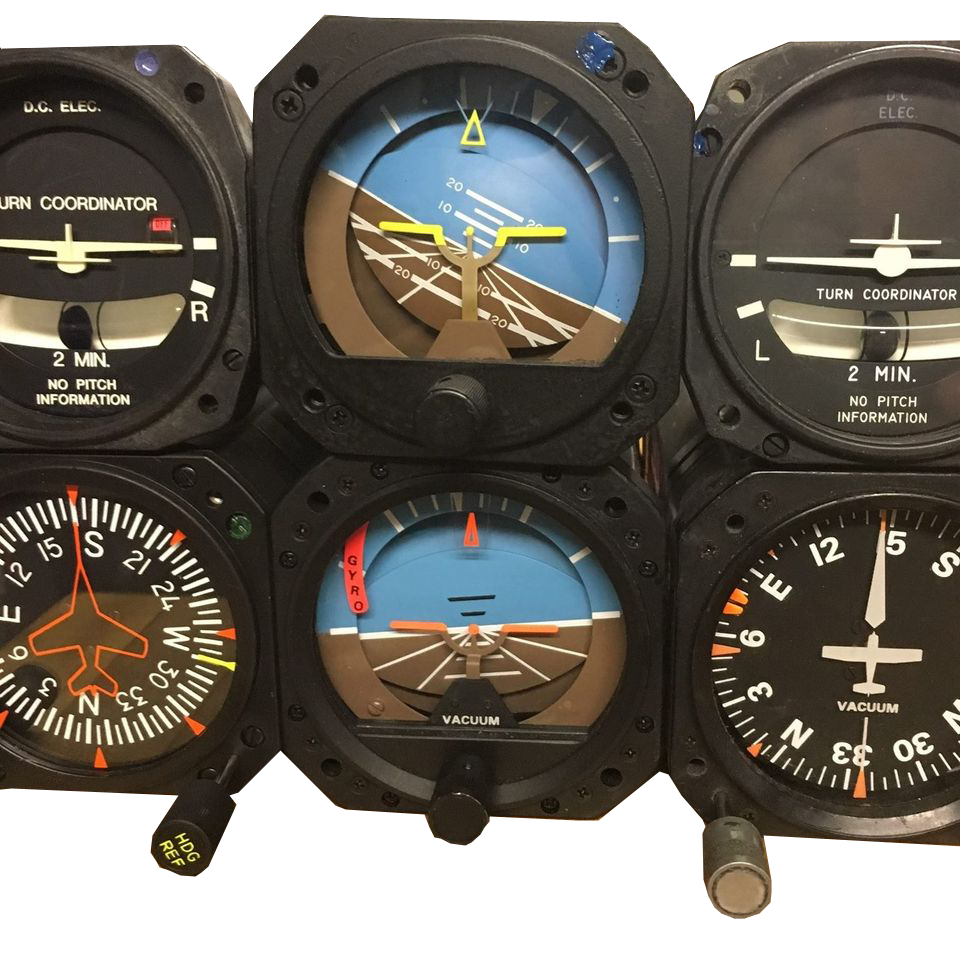
Nu-Tek Aircraft Instruments, Inc. is a FAA certified repair station specializing in aviation gyros. Nu-Tek has provided the best gyroscopic service, repair and sales for since 1987. Nu-Tek has a dedicated team with decades of experience delivering the highest quality service with unmatched client satisfaction in the aviation gyro business.




